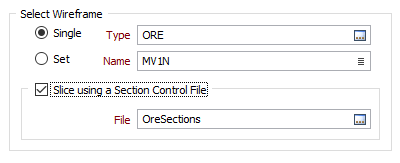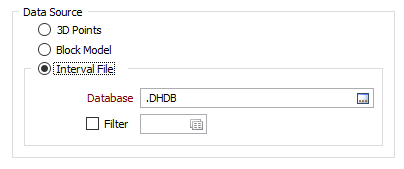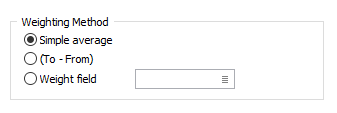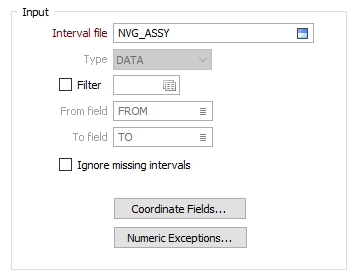Grade Tonnage
![]()
Select Wireframe
To process multiple wireframes in a wireframe set, select the Set option. When you create or edit a wireframe set, you can specify wireframes of several types. Wildcards and partial names may be used to select multiple wireframes for each type.
To process a single wireframe, select the Single option, select the type of the wireframe, and then the name of a wireframe of that type. Wildcards and a partial name in the Name input box may be used to select multiple wireframes. This will load the wireframe as if it were a wireframe set.

Note that wildcards in the Name input box will only be considered as a valid set definition, if the name does not already exist. In other words, it is possible for a wireframe name to contain a wildcard character, for example “+”.
See: Wildcards
Slice using a Section Control File
When a single wireframe is selected as the input, select the Slice mode option to perform a Wireframe Slice By Plane operation on the input wireframe.
Click the ellipsis button to select the section control file containing the sections that will be used to slice the input wireframe. The wireframe set that is produced as a result is then used as the input to the process.

Data Source
Specify the source of the input grades and coordinates.

3D Points
When the data source is a 3D Point file, each record is either included or excluded from the calculation, depending on whether the point is inside or outside the wireframe.
Block model
If you are using a block model file as the data source, a Block Model Calculation is used to calculate estimates. Each block value is weighted according to the volume of the block that is inside the wireframe.
If the block lies completely inside the wireframe, then a simple calculation, using the block dimensions, takes place.
If the block intersects the wireframe, a Boolean calculation determines the exact volume of the portion inside the wireframe. This is done automatically.
Because a block model file always uses volume-based weighting, the Method options are disabled.
Interval File
When the data source is an Interval file, each record is either included or excluded from the calculation depending on whether the mid-point of the interval is inside or outside the wireframe.
If the Weighting Method TO - FROM is selected, the actual interval length is used. No attempt is made to calculate what portion of the Interval falls inside the wireframe.
Drillhole databases support multiple key fields. Up to 3 Hole ID fields can be specified. This can be a useful feature, for example, when the holes imported from disparate datasets are known to have duplicate keys. When more than one Hole ID is specified, a concatenation of the Hole IDs is used to query the database using a unique key.
Hole IDs are taken from the nominated Drillhole Database (press F4 in the Drillhole Database box to view properties).
Weighting Method
If you have chosen 3D Points or Interval File as the Data Source, there are three methods you can use to weight the estimates:

- SIMPLE AVERAGE - This option calculates the average grade of points that occur in a wireframe.
- TO - FROM - this option only applies to drillhole interval data. The actual interval length is used. No attempt is made to calculate what portion of the interval falls inside the wireframe.
- WEIGHT FIELD - When you choose this option, the Weight field prompt is enabled. Enter the name of the field in the data file from which a weight factor will be obtained. The grade value is multiplied by the factor value in each record. The average grade is the sum of the grade * factor products divided by the sum of factors. Normally a field recording interval thickness would be used as the weight factor field.
The grade value is multiplied by the difference between the From and To values in each record. The sum of grades * (to-from)/sum of (to-from) is used when the average grade is calculated.
(The factor weighting could also be used, if the grades were in weight per unit volume units, to convert them to weight per weight units.)
Input
File
The option you have chosen as the Data Source (above) will determine which (File, Interval file, Block Model file) prompts are displayed and enabled here.
Double-click (or click on the Select icon) to select the name of the input file and optionally apply a filter to the file.

From and To fields
These fields are enabled when the data source is an Interval file - or when the TO - FROM weighting method has been chosen for a 3D Points data source.
Double-click to select the fields that define the From - To intervals in the file.
Ignore missing intervals
This option is enabled when the data source is an Interval file.
Select this option if you want the function to ignore missing intervals in the file. If you do not select this option, the missing intervals will be treated as though they are present and given a grade of 0.0. Thus, the length weighting will be adjusted.
Coordinate Fields
If you selected 3D Points or Block Model as the Data Source, specify the names of the Coordinate Fields in the Input file.
Numeric Exceptions
(Optional) Use the Numeric Exceptions group to control the way that non-numeric values are handled. Non-numeric values include characters, blanks, and values preceded by a less than sign (<).
Forms
Click the Forms button to select and open a saved form set, or if a form set has been loaded, save the current form set.
Run
Finally, click Run to run the function. (To view the Report file, right-click with the cursor in the Report file response).